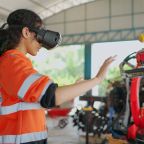Virtual Reality (VR) Training immerses learners in a simulated environment and tests their knowledge without facing real-world risk. But, did you know that learners could still potentially get injured or sick while completing VR training?
VR training can cause headaches, nausea, motion sickness, and eyestrain. Luckily, the following six tips are here to help.
- Keep VR training activities to 20 minutes
- Stay seated or block off space
- Sanitize equipment regularly
- Remove dangerous objects from the surrounding area
- Assign a spotter
- Create content in different formats
The VR industry is growing rapidly, with 168 million people worldwide predicted to have some form of VR installed by 2023. As VR for corporate training continues to become more popular, it’s essential to recognize potential risks associated with the technology.
VR training can help combat injuries experienced during training, but did you know it can also cause injuries and sickness?
In this article, we will discuss what VR Training is and six tips to conduct VR Training safely.
What Is VR Training?
VR Training uses a simulated world that enables learners to encounter true-to-life scenarios without facing real-world risk. By putting on a headset, learners are transported to a new location where they can look around themselves, walk up close to computer-generated objects, and interact with items and people.
VR is used in corporate training in the following ways:
- Scenario-Based Learning — Refine soft skills with a first-person perspective of real-life situations.
- Technical Skills — Teach employees how to assemble and disassemble products or work complicated machinery by allowing them to interact with digital re-creations.
- Multi-Step Tasks — Work through troubleshooting products and repair equipment by outline step-by-step guides for learners to follow.
- Onboarding — Introduce new employees to your organization by showing them the business’s ins and outs, shop floor, processes, and more.
- Simulations — Simulation-based training can teach learners how to handle hazardous situations without needing to be in person and use real-life equipment.
A significant benefit to VR training is that it creates a safe learning environment, but without proper safety precautions in place, learners could face potential physical health risks.
6 Tips To Conduct VR Training Safely
Keep VR Training Activities To 20 Minutes
VR is meant to be used for a short amount of time, not for multiple hours. For training, VR should be designed as a short activity to integrate into your program. Twenty minutes is the recommended usage time for a VR activity to avoid disorientation and other sicknesses.
Learners should participate in VR training programs that are around 20 minutes long, with 10-15 minutes breaks every 30 minutes. During breaks, learners can debrief and discuss their training experience with colleagues or use the time to take in-person assessments or reflections.
Stay Seated Or Block Off Space
VR training fully immerses a learner in a simulated environment, which cuts off any outside world view. This makes it impossible for learners to see the space around them. Blocking off an area in your office can help create a safe learning environment for VR users.
However, your best bet is to use VR while seated, unless the program requires learners to stand up and walk around. When users sit down while completing their VR training program, they can prevent the vast majority of accidents from happening.
Sanitize Equipment Regularly
VR equipment, including the headset and controllers, should be appropriately cleaned and sanitized. By cleaning and sanitizing VR equipment, organizations can ensure that they’re keeping learners safe. Some germs have a remarkable ability to survive on inanimate surfaces, such as VR equipment.
The three best sanitization practices for VR equipment are the following:
- Wash your hands prior to using VR equipment or wear gloves
- Use facial interface covers
- Clean devices before and in-between each use with nonabrasive antibacterial wipes
With Covid-19 changing the way organizations operate and lead training, it has never been more critical to keep VR equipment safe for use.
Remove Dangerous Objects From The Surrounding Area
You should ensure that learners are in a safe environment and away from other people, stairs, balconies, windows, furniture, or other items users could bump into. You should take the time to clear the area where the VR training is to ensure that learners won’t be at risk of bumping into objects and injuring themselves.
Assign A Spotter
The buddy system is a great idea for conducting VR training safely. This means that while one learner is participating in the VR program, the other person is spotting them. The spotter is responsible for watching out for the learner’s safety.
Given that VR programs are interactive and may require users to duck, extend their arms, jump, and more, a spotter can be a good way to ensure learners are safe while also building connections at your organization.
Create Content In Different Formats
A significant drawback to VR training is that some people can experience physical side effects, including headaches, nausea, motion sickness, and eyestrain. When using VR, learners may experience a disconnect in the brain that causes motion sickness, or they may have a headache or eyestrain because of the graphics or VR headset itself.
The solution to these symptoms is to create your program in alternative formats, such as a desktop web-version. This way, the training is taken outside of the headset and avoids physical side effects.
Have No Fear! Safe VR Training Is Here!
VR training comes with a variety of benefits that can be fully embraced when VR training is conducted safely. Through this article, we’ve covered what VR training is, as well as six tips to help combat VR training safety issues.
Are you interested in learning more about VR training or want to start designing a VR training program? Get started here.








